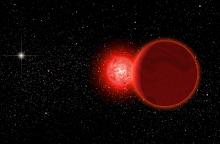Listen to today's episode of StarDate on the web the same day it airs in high-quality streaming audio without any extra ads or announcements. Choose a $8 one-month pass, or listen every day for a year for just $30.
You are here
Lacerta
Lacerta, the lizard, isn’t much to look at. Even the constellation’s brightest stars are quite faint. From light-polluted cities, in fact, they’re all but invisible.
The brightest is Alpha Lacertae. It’s about twice as big and heavy as the Sun, and a couple of dozen times brighter. It’s about a hundred light-years away — a distance that’s pretty well locked in.
The distance to the second-brightest star has been a little more uncertain. It had been thought to be about 625 light-years away, give or take a few dozen. But observations by Gaia, a European spacecraft, say the distance is only 560 light-years, with about the same amount of wiggle room.
And there was also a difference in the distance to the third-brightest star in the constellation, 5 Lacertae — about 1600 light-years for the old measurements, versus about 1750 for Gaia.
Knowing a star’s distance is pretty important. Combining the distance with how bright the star looks reveals its true brightness. Plugging all of those numbers into models of how stars work reveals the star’s size, its age, and other details. So a difference of just 10 percent in the distance can have a big impact in what we know about the star.
If you have clear, dark skies, away from most of the glow of city lights, look for Lacerta about half way up the northeastern sky at nightfall. It’s between W-shaped Cassiopeia, to the lower left, and beautiful Cygnus, the swan, to the upper right.






